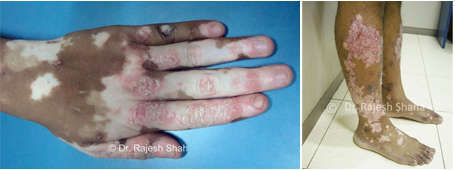Psoriasis: Understanding Psoriasis
Psoriasis is an obstinate skin condition in which red patches of various sizes develop on the skin that is covered with dry, silvery scales. Psoriasis is a chronic skin disease that got its name from the Greek word meaning, 'itch'.
Psoriasis is commonly misspelled as psoriasi, soriasis, psorisis, psorasis, psoraisis. Psoriasis is called as Chhal rog in Hindi
In psoriasis the skin becomes inflamed and red eruptions appear on the surface of the skin that begins to itch excessively. These areas form thickened areas (plaques) that are covered with silvery scales over the reddened lesions. The skin at the joints may crack.
Location:
Psoriasis most often occurs on the elbows, knees, scalp, lower back, palms, and soles of the feet. However, no area of the skin is exempt, including the genital area. The disease may also affect the fingernails and toenails, and the soft tissues inside the mouth. About 15 percent of people with psoriasis have joint inflammation that produces arthritis symptoms. This condition is called psoriatic arthritis.


(The pictures show psoriasis on back, legs, thighs, behind ears, nails, margins of hair. Other common areas are elbows and knees.)
Psoriasis is categorized as mild, moderate, or severe, depending on the percentage of body surface involved and the impact on the patient's quality of life.
The course of the disease:
The course of psoriasis is characterized by remissions and relapse. In some instances the patches disappear, just to appear after some period of time.
There are various factors ranging from climate, stress, infections, and injuries that can trigger a flare-up of disease within a short span of time even within a few days. On the other hand, there are certainly other factors such as sunlight that significantly reduces the intensity of the problem.
Impact on health:
In some cases, psoriasis is so mild that it may go unnoticed. At the opposite extreme, there are victims having psoriatic patches almost everywhere on the body. People with psoriasis may suffer discomfort, including pain and itching, restricted motion in their joints, and emotional distress.
The unpleasant appearance of the patches, the chronic itching and flaking of psoriasis although it is not life-threatening, has a definite impact on the self-esteem and lifestyle of the psoriasis victim. Substantial time and money are spent trying to keep it under control.
Incidence:
Psoriasis affects between 1-2 percent of the general population. In the US alone there are about 5.5 to 6 million people suffering from psoriasis.
Both males and females get psoriasis in equal numbers. It can strike at any age, but most often in adults between 15 and 35 years. However, a first-time diagnosis of psoriasis has been seen in very old people, and in newborn babies and small children.
Pathology:
Psoriasis is a chronic (long-lasting) skin disease characterized by scaling and inflammation.
Our skin is mainly made up of two layers: the epidermis (outer layer) and the dermis (inner layer). The cells of the epidermis are borne in the dermis and then they move up. At a regular interval of 28-30 days, the cells of the epidermis are replaced by new cells formed in the dermis.
In psoriasis, this process of cell production in the dermis is sped up. New cells are formed and moved upward to the skin surface faster than they can be incorporated into the skin. The excess cells accumulate and are scaled off in the form of flakes.
The psoriatic plaque has other features also, including inflammatory cells and dilated small blood vessels that contribute to both the appearance and the symptoms of a psoriatic lesion.

A Case of Concurrent Vitiligo and Psoriasis
You may see photos of a very rare case, where the patient has vitiligo and psoriasis concurrently. This 30 years old male was suffering from vitiligo for the past 5 years. He recently developed psoriasis in some of the vitiligo patches. Psoriasis has now spread to areas where the skin is not affected by vitiligo.
At Life Force center in Mumbai, we have been researching on Psoriasis for over two decades. Patients not only from Mumbai but from all over the country and from over 170 countries, visit our psoriasis clinic. All varieties of cases are systematically studied and treatment prescribed. Many dermatologist doctors from Mumbai and outside refer us cases for treatment.
Written & Approved by-
Dr. Rajesh Shah
M.D. (Hom.)